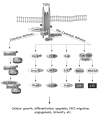The tale of transforming growth factor-beta (TGFbeta) signaling: a soigné enigma
- PMID: 19787707
- PMCID: PMC2810629
- DOI: 10.1002/iub.239
The tale of transforming growth factor-beta (TGFbeta) signaling: a soigné enigma
Abstract
Transforming growth factor-beta (TGFbeta) is a secreted cytokine, which intricately controls a plethora of physiological and pathological processes during development and carcinogenesis. TGFbeta exerts antiproliferative effects and functions as a tumor suppressor during early stages of tumorigenesis, whereas at later stages it functions as a tumor promoter aiding in metastatic progression through an autocrine TGFbeta loop. Intricate knowledge of TGFbeta signaling and its regulation are still evolving. In this review, we make an attempt to showcase the associated enigma of TGFbeta signaling in its dual functional role as tumor suppressor and metastatic promoter during early and late stages of carcinogenesis, respectively.
Figures


References
Publication types
MeSH terms
Substances
Grants and funding
LinkOut - more resources
Full Text Sources
Other Literature Sources
Miscellaneous

